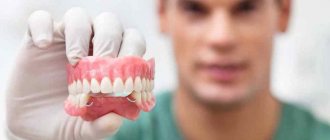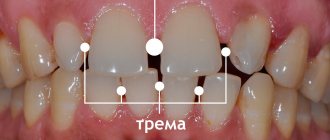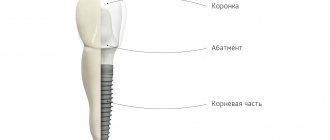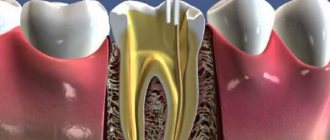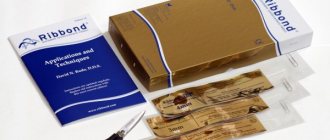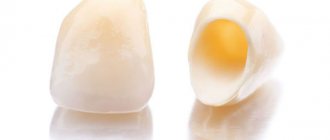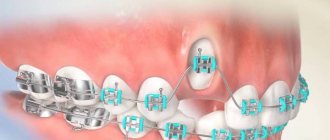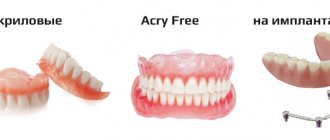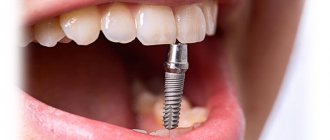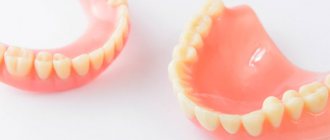Over time or in the absence of proper care, teeth begin to deteriorate, but even with severe damage, they can be saved if anchor pins are used.
The tooth is supported by a special structure similar to a rod. It is installed at the root, and a crown or bridge is fixed on top. Thus, the vitality of the root is maintained. In addition, such restoration is much cheaper than prosthetics.
But before a decision is made to install an anchor pin, a thorough medical examination is necessary, since this procedure has contraindications. These include periodontal diseases, untreated caries, diseases of the blood and nervous system, curvature, obstruction or short length of root canals, etc.
If there are no contraindications, the attending physician selects a design based on the following factors:
- degree of tooth root destruction;
- root wall thickness;
- optimal installation depth of the anchor pin.
Pin in a tooth - what is it?
Phrases from the series “putting a tooth on a pin,” “building a tooth on a pin,” or “tooth under a pin” sound quite scary for many patients. However, in reality, restoring a tooth with a pin will help avoid its removal, and the design itself does not cause any discomfort. A dental pin is placed into the root canal. The device performs a supporting function and helps to optimally distribute the load on the tooth. Since a pin is placed in the root of the tooth, a number of therapeutic and endodontic procedures must be carried out before starting treatment.
Indications for installing a pin in a tooth
- Serious damage to the coronal part. A tooth without a post has a higher risk of destruction after treatment if more than 50% of its visible part is initially damaged.
- Repeated dental treatment due to secondary caries or destruction of tooth tissue due to other reasons.
- The need for additional supporting and fixing elements for installing a crown.
- When preparing the abutment tooth for fixing the prosthesis.
- For the treatment of advanced forms of periodontitis and periodontal disease. Pins are installed on loose teeth for subsequent splinting.
- During tooth replantation (in rare cases).
Contraindications to the procedure are related to the condition of the tooth (severe damage, too thin walls), anatomical features and pathologies of the root canal structure, as well as concomitant diseases (caries, acute periodontitis, cyst, granuloma, abscess, mental disorders) and body conditions (pregnancy) .
Seal + pin = Error?!
Since 1792, dentists have been searching for the perfect tooth post. Almost 300 years have passed, and the mythical perfect pin has not been found. Is it really necessary?
Valentina Vladimirovna Khalyavka, general director and orthopedic dentist of the Dental Clinic “Dentist”, speaks about the problem of treating periodontal diseases. (Article from the archives of the magazine “Women’s Health” Copyright entirely belongs to dentist V.V. Khalyavka)
Features of dental pinning, or why specialists at the Dentist clinic prefer more modern tactics.
Filling with a pin - what is it?
Increasing the strength of a tooth means extending its life. One of
The most popular solution to this problem for a long time was the use of pins. They are a ready-made structure that looks like a threaded rod. After expanding the canal mechanically, the pin is fixed directly into the canal of the tooth root, with cement, or screwed in like a screw, after which the remaining stages of restoring the damaged tooth are carried out. A filling with a pin is very often used in practice by dental therapists without a crown and orthopedic dentists with a crown.
IMPORTANT:
Pinning teeth and covering them with a crown is a gross orthopedic mistake, as well as a therapeutic one, which in the future will lead the patient to tooth extraction with subsequent implantation. That is why the most modern dental centers opt for other technologies.
Crown or filling on a post.
The question of which is better, a pin with a filling or a crown, is still relevant for many dentists. However, clinic specialists
“Dentist”, based on long clinical studies and personal observational experience, consider the choice in favor of dental pinning to be unsafe and extremely harmful. In clinical studies, it was proven that a filling on a pin leads to the removal of teeth in 70% of patients. Extraction (removal) of teeth in the roots of which metal pins were installed was carried out in connection with a root fracture. The reason for this is that pinning negatively affects the biomechanics of the tooth. During the endodontic protocol (treatment), the canal is widened, which has an acceptable limit. When a pin is installed, the expansion of the canal goes beyond the permissible limits and the walls of the tooth root become very thin. Inserting a pin into the root leads to a wedging effect. When chewing, the action of external forces becomes excessive, deformations occur, which lead to rupture or fracture of the root. Extraction (removal) of teeth in the roots of which metal pins were installed was carried out due to a root fracture.
IMPORTANT:
According to specialists at the Dentist clinic, the use of pins in everyday practice is a gross mistake, which in the future will lead to tooth extraction.
Thanks to modern technologies and the use of the latest generation of light materials (Enamel and Estet-X), our doctors carry out large dental restorations without the use of pins
. Restorations, like fillings made from the latest generation materials, serve their owners for a long time, more than 15 years!
For teeth with severely damaged coronal parts, we recommend core inlays
made of metal, inlays made of composite materials and zirconium dioxide. These additional expenses will definitely pay off in that you will not soon have to resort to tooth extraction where a filling was previously installed on a pin, further installation of a bridge structure, or implantation. Patients fully support this approach and consider the clinic one of the best in Moscow, which is clearly reflected in their positive reviews.
What dangers and harm does dental pin therapy pose for patients?
I began my career as a therapist-orthopedist-dentist after graduating from dental institute and residency 25 years ago. Few people know that the work of a dentist of any specialty requires the doctor to have in-depth knowledge of physics, namely mechanics and biomechanics, strength of materials and chemistry. And this is not without reason. Did I surprise you?! The entire chewing function of the jaw apparatus operates and works according to the laws of physics. Ignorance by a dentist of the basics of physics and mechanics leads our patients to tooth extraction, breakage of orthopedic structures, rejection of implants, and everything that is called medical error!
Until now, I am faced with metal pins twisted into the canals of the tooth, a “dentist” and I see the consequences that lead to fracture of the roots of the teeth, decementing of crowns, bridges and always, as a result, removal! Patients pay special attention to the issue of preserving natural teeth. The desire to preserve teeth for a long time also increasingly extends to those teeth whose crowns are severely damaged.
IMPORTANT:
Patients are not certified specialists in the field of dentistry; they often do not understand the principles of this or that treatment path, and in fact they should not understand!! They turned to a specialist dentist who will explain, suggest and help!
And so the “walk through agony” begins. A song as old as the world that “dead teeth” (the nerve has been removed) are very fragile and they must be strengthened with a metal pin, or a non-metal one, it is simply necessary to reinforce them, since the filling will not hold, and crown and bridge! If today the dentist does not have knowledge and scientific evidence about the dangers of “pin therapy,” I will try to reach out to patients. After all, these are their teeth and they want to preserve them at any cost!
And how great it sounds: “A restored tooth with a pin will last much longer (at least 5-7 years) and will withstand increased chewing loads.
IMPORTANT:
The opinion that: “Restorations using root pins are a good treatment method that sufficiently ensures fixation of the restoration during orthopedic work” is deeply erroneous and has long been outdated!
Scientific research.
"Long-term clinical studies that have been conducted
Axelsson et al.
(1991) over a 15-year period clearly showed that pins and screws placed in the root canal had an adverse effect on the prognosis of the tooth. At the same time, a total of 71 teeth were removed from 59 patients, of which 48 teeth (69%) were removed after endodontic treatment and installation of a root pin. Extraction of these teeth was performed due to a root fracture. Also Eckerbom et al. (1991) indicated in their clinical studies, which were carried out over 5-7 years, that the rate of extraction of teeth in the roots of which metal pins were installed was higher than that of teeth without a root post.” All these research observations were always available, and each doctor could obtain reliable information if desired.
It has been proven that the root post:
- Does not stabilize the tooth root or strengthen it.
- Does not contribute to the retention of the filling in any situation.
- Does not contribute to the redistribution of load during chewing.
Consequences of the pin + filling design.
- Weakens the root due to its strong expansion.
- The pin + seal makes the structure heavier.
- Leads to root fracture - fracture.
- Removal followed by prosthetics and implantation.
- Corrosion of stainless steel pins, which leads to tooth root fracture.
Why do all pins negatively affect the root of the tooth?
From the physics course we know that all solids experience deformation: shear, compression, bending, torsion. Depending on the material, each item has its own margin of safety. Strength is the ability of a material to resist destruction and for everyone it has its own limit. When carrying out endodontic treatment, we are forced to intervene in the biomechanics of the tooth. Carry out instrumental treatment, namely expansion of the canal. But there is a permissible limit of expansion, beyond which we actually weaken the foundation of the tooth. The human tooth, like the bone (periodontal) in which it is located, experiences elastic deformation, compression and tension deformation during chewing, but perceives it adequately. But as soon as the action of external forces becomes excessive, plastic deformations occur, which lead to destruction.
IMPORTANT:
When installing a screw pin, a wedging effect is created, the pin moves, uneven distribution of the chewing load and, as a result, root rupture.
But what about elastic pins? Yes, apparently they at least guarantee that the tooth root will not be torn in the future. And there is no convincing evidence about the benefits of these pins.
What is the price of pin therapy?
Pinning teeth and covering them with a crown is a gross orthopedic mistake, as well as a therapeutic one, which in the future will lead the patient to tooth extraction with subsequent implantation. This is such a high price for something harmless and not so
an expensive filling made of medium quality material on a pin! Modern technologies and high-quality materials make it possible today to carry out large dental restorations without the use of pins
.
Restorations, like fillings made from the latest generation materials, serve their owners for a long time. For teeth with severely damaged coronal parts, there are more durable and safe designs: core inlays, inlays made of composite materials and zirconium dioxide.
Of course, these are additional costs, but they are worth it, since you will not have to start traditional bridges or implants in two years or less.
IMPORTANT: The patient considers the situation hopeless, the way out of which he does not like.
Dentistry has firmly become commercial in the 21st century, and competition is very high in the market for these services.
There is nothing wrong with that and this is natural. The question is about the quality of services, their adequacy and benefit for the patient? I never followed the lead of patients, and did not allow roles to be changed; the patient became a doctor, the doctor became the executor of his desires. This is an important point, and the material aspect has never been a priority for me in such situations. The moral and professional aspects have always been the leading ones for me when working with such patients, and there were quite a few of them. The answer was and is always the same: “Apparently, you need a doctor of “higher qualification” and “with a different level of knowledge”!!” “The only thing satire should do is alarm. If the addressee of satire is not complete……., he will be wary, sensing arrows” Alexander Shirvindt.
Dental pins - what are they?
Today, doctors have a wide selection of dental pins, varying in shape, material and area of application.
Dental pin materials
- Metal.
The most popular options: titanium, brass, palladium and precious alloys. - Metal-free.
They are made from gutta-percha, ceramics, fiberglass and carbon fiber.
Forms
- screw
- cylindrical
- conical
- combined
Recovery methods
- pins for tooth crown
- tooth filling on a pin
Mounting methods
- Active.
Threaded pins are screwed into the root canal, thereby achieving a tighter fixation. However, there is a risk of perforation of the canal walls. - Passive.
A more gentle (but less reliable) method of fastening. The pin is placed inside the root canal and fixed using a special compound.
Anchor pin: types of materials and type of fixation
The rod for the crown has several classifications. Depending on the type of fixation, the pins can be passive or active. The first option is held in place by cement mortar. The active type anchor structure comes with a thread, which allows you to more securely fasten the rod in the root zone.
The devices themselves are made from different materials:
- carbon fiber
- The most elastic material, with characteristics closest to the material of a human tooth; - gutta-percha
pins are the lightest, but the most short-lived, and do not allow you to build up a crown for decades; - titanium
- the most durable; - fiberglass
- lightweight and hypoallergenic.
During an individual consultation, the dentist will help you choose the type and material of the structure. The price of a dental post in Moscow and the cost of the extension procedure depend on this.
Types of dental pins
Gutta-percha
Filling dental canals with gutta-percha pins allows you to achieve predictable results, since the entire root canal cavity is filled. However, the gutta-percha pin cannot perform a full support function.
Metal pins in teeth (anchors)
Most types of anchor pins are made of metal, threaded, and installed using the active method. An anchor pin in a tooth is a classic option that is most often used for fixing crowns (a crown on a tooth on a pin). There are also modern analogues: these pins have a smooth surface and are made of ceramic, but some experts no longer call these products anchors.
Fiberglass
Fiberglass teeth pins are sufficiently strong, elastic and safe. They are almost transparent, so they are actively used to restore teeth in the smile area. The front tooth on a fiberglass post looks quite aesthetically pleasing, since the material does not stain over time and is generally quite durable.
Carbon fiber
Another type of modern and popular pins, which are as similar as possible to the structure of dental tissues. They are very durable, help to optimally distribute the load and prevent root fractures.
Attention!
To restore teeth, pin inlays are also used - these are solid structures made of metal alloys or ceramics, the base of which is installed in the root canals, and the stump imitates part of the crown.
Restoring a tooth stump with a fiberglass pin or a cast inlay?
An important element in the restoration of severely damaged teeth (“destroyed to the ground”), i.e.
at the gum level - this is the presence of a section of tooth tissue above the gum level of at least 1.5 mm (an element called a ferrule), precise fitting of the intra-root pin, and fixation with adhesive cements. Individual cast metal stump inlays have extensive historical experience in use. However, as noted in the literature: “Cast cores also exhibit a high rate of root fracture due to rigidity, taper, and precise adaptation to the dentin walls.” Pathways of the pulp; 8th Edition,2002 (Fig. 1)
The stress that develops due to the high-energy potential of the molecular structure of the metal is higher than the rate of irreversible deformation of the dentin of the tooth root.
How is a pin inserted into a tooth?
Installing a pin into the root of a tooth is a rather labor-intensive process, including diagnosis and preliminary treatment of canals. Further actions depend on the treatment method. The first option is to place a pin and build up the tooth using composite materials. The second option, a tooth prosthesis on a pin, involves installing a crown. Dental prosthetics with a pin is not performed. The role of the prosthesis is performed by the crown, and the pin is only an additional supporting element. Finally, the extended tooth on the pin is polished and brought into proper condition. In the case of a crown, the doctor makes sure that the prosthetics was successful.
Prices
| The doctor's consultation | For free |
| Titanium | From 1,250 ₽ |
| Fiberglass | From 3,000 ₽ |
Expert of the article you are reading: Svetlana Viktorovna Derevyakina Chief physician, doctor of the highest qualification category, therapist, periodontist, leading specialist of the NovaDent network
27 years
Clinical experience
Petrovsko-Razumovskaya
Verkhniye Likhobory
st. Dubninskaya, 27, building 1
+7
Free consultation with this specialist
Titanium pin in tooth
The pins located in the tooth canals can be made of titanium, but they should not be confused with implants. Dental pins belong to endodontics and partly to orthopedics, while implantation is a separate area. When a titanium pin is placed in an extracted tooth, the product is called an “implant.” This is an artificial root that is implanted in place of a lost tooth. Theoretically, a dental implant can be called a titanium post (which many people often do), but compared to classic posts, it performs a completely different function. The advantages of implantation today are undeniable: if a natural tooth is lost, it is the implant that can best restore its functionality and aesthetics.
Alexander Grigoriev.
active member of the American Dental Academy
In practice, we often encounter the need for functional rehabilitation after endodontic treatment. Unfortunately, the procedure for treating a tooth's root canal involves significant excision of the tooth's dentin. At the same time, we excise the interaxial dentin and dentin of the pulp cap.
These two areas of tooth tissue are the most important in determining the strength characteristics of the treated tooth. Our task is to restore these elements. This is a stump root tab.
What to do if a tooth with a pin hurts?
Painful sensations may well occur after installation of the pin, since surrounding tissues were affected during the treatment process. Often, unpleasant sensations occur after depulpation, especially with the use of arsenic. A tooth without a nerve and a pin should not hurt, since it is dead. If a tooth hurts after installing a pin and these sensations do not go away for several days, there is a risk that the treatment was carried out with errors and complications arose. In this case, you should consult a doctor as soon as possible.
Why use dual cure systems?
Dual-curing systems, as well as fiberglass posts, have been used in dentistry for relatively recent times. Previously, traditional cements based on phosphates and glass ionomers were used to fix implants and other artificial materials. However, such materials provide insufficient adhesion. Considering that the adhesion of the surface of fiberglass pins is already quite low, installing them on traditional materials is fraught with possible loss and destruction, often right during therapeutic or restoration work with a filled tooth.
At the same time, the use of dual-curing systems, also called composite luting cements (which, by the way, is incorrect, because they are not such), is more justified from the point of view of ensuring durability. Such bonding agents, due to their chemical activity after application, establish a strong bond with both tooth dentin and filling materials. This ensures not only reliable fixation of the fiberglass pin, but also complete sealing of the root canals.
Is it worth putting a pin in a tooth?
Like all dental treatment methods, pins have their drawbacks. This list is small, but these nuances must be kept in mind before agreeing to treatment.
- Allergic reactions to metal alloys are possible.
- Even with ideal treatment, a tooth with a pin will be more vulnerable than a healthy tooth. Its service life is shortened and the tooth becomes more fragile.
- The risk of root fracture increases (especially when using classic anchor pins).
On the other hand, this technique allows you to save a tooth in almost hopeless conditions.
Benefits of using pins
The use of dental pins allows you to achieve excellent results in the treatment of caries. Main advantages of the designs:
- — restoration of anterior and lateral teeth;
- - absence of rejection reactions;
- — quick tooth restoration in 1 appointment;
- — high aesthetic results;
- - long service life of structures and their high strength.
However, if the root part of the tooth is damaged, it will not be possible to place a pin. Also, the structure cannot be placed in the canals without first removing the pulp. If there are contraindications for installing pins, doctors at our clinic offer alternative treatment methods that will be no less effective.
Posted by:
Installation of a dental post
Several procedures are performed here:
- A treatment regimen is determined. The doctor tells how the pin will be installed, what material is best suited for the patient;
- The tooth is being prepared. It is processed and the filling, if any, is removed. In the case of a pin made of fiberglass or carbon fiber, the excess material is trimmed off. The rod is then fixed inside the canal using a composite;
- When the pin is fixed, the cement has hardened, and the part of the tooth that is the crown is restored. If the pin is on the front tooth, then you need to carry out artistic restoration so that it acquires a natural shade.
Caring for a rooted tooth
After the procedure, the patient is advised to carefully monitor the condition of the oral cavity. For a week, the patient is advised to eat exclusively pureed soft foods. After eating, the gums and tooth canals should be cleaned of food debris using dental floss. This hygiene procedure will reduce the risk of inflammatory processes.
Dentists advise distributing the load on the dentition evenly. The patient should refrain from opening bottle caps with a ground tooth or cracking nut shells.
If the tooth decay is significant, then there is no point in saving it. But increasingly, dentists resort to extreme measures only in rare cases. Doctors have learned how to save a tooth that would have been considered hopeless just a few years ago. It should be remembered that for the health of the body it is better to restore a tooth than to remove it. A dental pin is one of the most common and effective methods for reconstructing damaged canals.
Sources used:
- Handbook of Dentistry / Ed. A. I. Rybakova. - M., 1993.
- Seifollahi M. Preparation of lateral teeth for all-ceramic inlays // News of Dentistry: article. — 2008.
- Tabs in dentistry Wikipedia article
